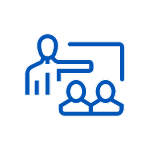4-day instructor-led training course
- Microsoft Official Course content
- Hands-on learning labs included
- After-course instructor coaching included
- MOC exam voucher included in course tuition
Get the Advantage 37 295 kr
- Take this course and gain unlimited access to more than 300 virtual instructor-led courses
- Future-proof your career with more than 100 sought-after certifications in the market
- Build real skills through hands-on learning in more than 180 virtual labs
- Grow your skills and capabilities with more than one course at a time and save
Thank you for choosing subscriptions!
-
Guaranteed to Run - you can rest assured that the class will not be cancelled.jan 28 - 31 15:00 - 22:30 CETNew York or AnyWare
-
feb 18 - 21 15:00 - 22:30 CETHerndon, VA or AnyWare
-
mar 4 - 7 10:00 - 17:30 CETLondon or AnyWare
-
mar 4 - 7 9:00 - 16:30 CETStockholm or AnyWare
-
mar 25 - 28 15:00 - 22:30 CETAustin or AnyWare
-
maj 27 - 30 15:00 - 22:30 CESTOttawa or AnyWare
-
jun 2 - 5 10:00 - 17:30 CESTLondon or AnyWare
-
jun 2 - 5 9:00 - 16:30 CESTStockholm or AnyWare
-
jun 10 - 13 15:00 - 22:30 CESTNew York or AnyWare
-
jul 15 - 18 15:00 - 22:30 CESTHerndon, VA or AnyWare
-
sep 9 - 12 10:00 - 17:30 CESTLondon or AnyWare
-
sep 9 - 12 9:00 - 16:30 CESTStockholm or AnyWare
-
sep 16 - 19 16:00 - 23:30 CESTAustin or AnyWare
Scroll to view additional course dates




